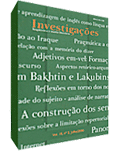CONSTRUÇÃO DOS SENTIDOS NO DISCURSO: UMA ABORDAGEM SOCIOCOGNITIVACONSTRUÇÃO DOS SENTIDOS NO DISCURSO: UMA ABORDAGEM SOCIOCOGNITIVA
Abstract
Partindo da concepção de cognição como atividade e pressupondo uma noção de língua sob o ponto de vista não formal, o trabalho desenvolve a idéia de que toda atividade referencial é construída dentro de processos sociointeracionais situados. É nesse contexto que funcionam os articuladores textuais para produção e explicitação dos sentidos.
References
— APOTHÉLOZ, Denis; Marie-José REICHLER-BÉGUELIN. 1995. “Construction
de la référence et stratégies de désignation”. In: BERRENDONNER, Alain; M-J.
REICHLER-BEGUELIN (eds), p. 227-271.
— APOTHÉLOZ, Denis. 1995. “Nominalisations, réferents clandestins et
anaphores atypiques”. In: BERRENDONNER, A. e M-J REICHLER-BEGUELIN
(eds), p.143-173.
— APOTHÉLOZ, Denis; Catherine CHANET. 1997. Défini et démonstratif dans les
nominalisations. In: DE MULDER, Walter & Carl Vetters (eds.), Relations
anaphoriques et (in)cohérence. Amsterdam: Rodopi, p.159-186.
— AUTHIER, Jacqueline. 1981. “Paroles tenus à distance”. In: Materialités
discoursives, Presses Universitaires de Lille.
— BEAUGRANDE, Robert de & DRESSLER, Wolfgang U. 1981. Einführung in die
Textlinguistik, Tübingen, Niemeyer.
— BERRENDONNER, Alain; Marie-José REICHLER-BEGUELIN (eds). 1995. .Du
syntagme nominal aux objets-de discours. SN complexes, nominalisations,
anaphores. Tranel v. 23, Neuchâtel, Institute de Linguistique de l’Université de
Neuchâtel, dez.
— CLARK, Herbert. 1992. Arenas of Language Use. Chicago, Chicago University
Press.
CONTE, Elisabeth. 1996. “Anaphoric encapsulation”. Belgian Journal of
Linguistics: Coherence and anaphora, v. 10, p.1-10.
FRANCIS, Gill. 1994. Labelling discourse: an aspect of nominal-group lexical cohesion. In: COULTHARD, Malcolm (ed.), Advances in written text analysis. Londres: Routledge,
JOHNSON-LAIRD, P. N. 1983. Mental Models. Cambridge: Cambridge
University Press.
JUBRAN, Clélia C.S. 2003. Parentetização. In: Gramática do Português Falado, vol.1: Construção do texto falado, Edunicamp.
KOCH, I.G.V. 1984. Argumentação e linguagem. São Paulo: Cortez.
______. 1989. A coesão textual. São Paulo: Contexto.
______. 1992. A inter-ação pela linguagem. São Paulo: Contexto.
______. 1997. O texto e a construção dos sentidos. São Paulo: Contexto.
______. 2002. .Desvendando os segredos do texto. São Paulo, Cortez.
______. 2004. Introdução à Lingüística Textual. São Paulo, Martins Fontes.
______.1999. Referenciação: Construção discursiva. Ensaio apresentado por ocasião do concurso para Titular em Análise do Discurso do IEL/UNICAMP, dez.
KOCH, Ingedore G. V; Luiz. Antônio MARCUSCHI. Processos de referenciação na produção discursiva. D.E.L.T.A ., vol.14, no. especial, p.169-190, 1998.
KOCH, Ingedore G.V.; LIMA, Maria Luíza A. C. 2004. “Sociocognitivismo”. In: MUSSALIN, Fernanda & BENTES, Anna Christina, Introdução à Lingüística, vol. 3, São Paulo, Cortez.
LESNIEWSKI, S. 1989. Sur les fondements de la mathématique. Fragments. Trad, de G. Malinowski, Paris, Hermes.
MARCUSCHI, Luiz Antônio; Ingedore V. KOCH Estratégias de referenciação e progressão referencial na língua falada. In: ABAURRE, Maria Bernadete (org.), Gramática do Português Falado, vol. VIII, Campinas: Edunicamp, 2002 [1998].
— MONDADA, Lorenza; Danielle DUBOIS. 1995. Construction des objets de
discours et catégorisation: une approche des processus de référentiation. In: A.
BERRENDONNER & M-J. REICHLER-BÉGUELIN (op. cit.), pp.273-302.
MONDADA, Lorenza. 1994. Verbalisation de l’espace et fabrication du savoir: approche linguistique de la construction des objets du discourse. Lausanne, Université de Lausanne.
______. 2001. Gestion du topic et organization de la conversation. Cadernos de Estudos Lingüísticos 41, Campinas, IEL/UNICAMP, pp. 7-36.
MORATO, Edwiges; KOCH, Ingedore G.V. 2003. “Linguagem e cognição: os (des)encontros entre a Lingüística e as Ciências Cognitivas”. In: Cadernos de Estudos Lingüísticos 44, Campinas, IEL/UNICAMP, pp. 85-91.
MINSKY, M. 1975. A framework for representing knowledge. In P.WINSTON (ed.). The Psychology of Computer Vision. Chicago: Mc Graw - Hill.
PRINCE, Ellen. 1981. Towards a taxonomy of given-new information. In: COLE, Peter (ed.), Radical Pragmatics, New York, Academic Press.
RUMELHART, D.E. 1980. “Schemata: The building blocks of cognition”. In: R.J. SPIRO et al. (orgs.). Theoretical Issues in Reading Comprehension. New Jersey: Erlbaum.
SACKS, Harvey. 1972. “On the analizability osf stories by children”. In: GUMPERZ, J. & HYMES, D. (orgs.), Directions in Sociolinguistics. New York, Rinnehart & Winston, pp. 324-345.
SCHANK, R.C.; ABELSON, R. P. 1977. Scripts, Plans, Goals, and
Understanding: An Inquiry into human knowledge structures. Hilsdale, Erlbaum.
SANFORD, A .J. & S.C. GARROD. 1985. “The role of background knowledge in psychological accounts of text comprehension”. In: ALWOOD & HJELMQUIST (eds.). Foregrounding background”. Lund: Doxa.
SCHWARZ, Monika. 2000. Indirekte Anaphern in Texten.Tübingen: Niemeyer.
VAN DIJK, Teun A. 1992 (1989). Modelos na memória - o papel das
representações da situação no processamento do discurso. In: Cognição, Discurso e Interação. São Paulo, Contexto.
VAN DIJK, Teun A.; KINTSCH, Walter. 1983. Strategies of discourse comprehension. New York, Academic Press.
VARELLA, F.; THOMPSON, E.; ROSCH, E. 1992. The embodi
Downloads
Published
How to Cite
Issue
Section
License
Copyright (c) 2005 Ingedore G. Villaça Koch

This work is licensed under a Creative Commons Attribution 4.0 International License.
Authors who publish with Revista Investigações agree to the following terms:
Authors retain copyright and grant the journal right of first publication with the work simultaneously licensed under the Creative Commons Attribution 4.0 International (CC BY 4.0) license that allows others to share the work with an acknowledgement of the work's authorship and initial publication in this journal.
Authors are able to enter into separate, additional contractual arrangements for the non-exclusive distribution of the journal's published version of the work (e.g., post it to an institutional repository or publish it in a book), with an acknowledgement of its initial publication in this journal.
You are free to:
Share — copy and redistribute the material in any medium or format for any purpose, even commercially.
Adapt — remix, transform, and build upon the material for any purpose, even commercially.
The licensor cannot revoke these freedoms as long as you follow the license terms.
Under the following terms:
Attribution — You must give appropriate credit , provide a link to the license, and indicate if changes were made . You may do so in any reasonable manner, but not in any way that suggests the licensor endorses you or your use.
No additional restrictions — You may not apply legal terms or technological measures that legally restrict others from doing anything the license permits.

